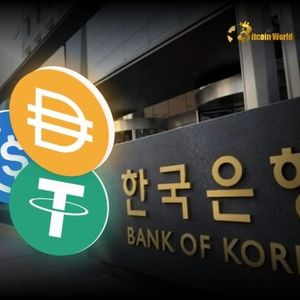Stablecoin Regulation: Bank of Korea Takes Crucial Steps Ensuring Stability
5 min read
BitcoinWorld Stablecoin Regulation: Bank of Korea Takes Crucial Steps Ensuring Stability Are you invested in stablecoins or watching the evolving world of digital finance? The regulatory landscape for cryptocurrencies, especially stablecoins, is rapidly taking shape globally. In South Korea, the Bank of Korea (BOK) is actively working to establish a robust framework. Understanding the nuances of stablecoin regulation is crucial for anyone navigating this space. Why is Stablecoin Regulation a Priority for the Bank of Korea? Bank of Korea Governor Rhee Chang-yong recently highlighted the central bank’s commitment to developing a comprehensive regulatory approach for stablecoins. According to a report by SBS Biz, Governor Rhee emphasized the need to work collaboratively with relevant government agencies to address potential risks. The primary goal is twofold: Ensuring Stability and Utility: The framework aims to allow stablecoins to function effectively within the financial system, leveraging their potential benefits while mitigating risks that could impact financial stability. Preventing Regulatory Loopholes: A key concern is preventing stablecoins from being used to circumvent existing regulations, particularly foreign exchange controls. Governor Rhee acknowledged that stablecoins play a significant role in driving fintech innovation . Their ability to offer relatively stable value compared to volatile cryptocurrencies like Bitcoin makes them useful for payments, remittances, and various decentralized finance (DeFi) applications. However, this very characteristic – their function as potential substitutes for legal tender – is what raises regulatory red flags for central banks and financial authorities worldwide. What Challenges Do Stablecoins Pose? While stablecoins offer exciting possibilities for faster, cheaper transactions and new financial products, their unique nature presents challenges that traditional financial regulations weren’t designed to handle: Risk to Financial Stability: Depending on their backing (fiat-backed, crypto-backed, algorithmic) and scale, a failure or ‘de-pegging’ event could have ripple effects across the crypto market and potentially impact the broader financial system, as seen during past market events. Consumer Protection: Lack of clear regulation can leave users vulnerable to fraud, mismanagement of reserves, or loss of funds if a stablecoin issuer fails. Money Laundering and Illicit Finance: Like other cryptocurrencies, stablecoins can potentially be used for illicit activities if not properly regulated and monitored. Circumventing Capital Controls: The ease of transferring stablecoins across borders poses a challenge to countries that maintain strict controls over the movement of capital and foreign exchange. This is a specific concern highlighted by the Bank of Korea . Addressing these challenges requires a delicate balance – fostering innovation while safeguarding the financial system and protecting consumers. How is the Bank of Korea Engaging Globally? Regulatory efforts are not happening in isolation. The Bank of Korea is actively participating in international initiatives to stay ahead of the curve and contribute to global standards. Governor Rhee specifically mentioned the BOK’s involvement in the Bank for International Settlements’ (BIS) Project Agorá . Project Agorá is a collaborative project involving multiple central banks (including the BOK) and private financial institutions. Its focus is on exploring the potential of tokenized commercial bank deposits and institutional CBDC s (Central Bank Digital Currencies) for international settlements. Key objectives of Project Agorá include: Investigating how tokenization can improve the efficiency of cross-border payments. Exploring the interoperability between different digital forms of money (tokenized deposits and institutional CBDCs). Developing a digital financial infrastructure that could reduce costs and increase speed in international transactions. This participation underscores the BOK’s recognition that digital currency regulation and infrastructure development require international cooperation. While stablecoins are a private sector innovation, their potential integration into the financial system necessitates coordination with central bank digital currency efforts and traditional financial regulations. CBDC vs. Stablecoins: What’s the Connection? The mention of institutional CBDC s in the context of Project Agorá highlights the broader digital currency landscape. While stablecoins are issued by private entities and pegged to existing assets (like fiat currency), a CBDC is a digital form of a country’s official currency, issued and backed by the central bank itself. Central banks globally are exploring CBDCs for various reasons, including improving payment systems, fostering innovation, and maintaining monetary sovereignty in a digital age. Institutional CBDCs, like those explored in Project Agorá, are typically designed for use by financial institutions for interbank settlements, rather than for the general public. The development of stablecoin regulation and the exploration of CBDCs are interconnected. Both involve the digitization of money and its potential impact on financial systems. Central banks are keen to ensure that private digital currencies like stablecoins operate within a framework that complements, rather than undermines, the stability and effectiveness of official currency and payment systems. What Does This Mean for Fintech Innovation? Governor Rhee acknowledged the positive contribution of stablecoins to fintech innovation . Clear and balanced regulation, while sometimes viewed skeptically by the crypto community, can ultimately foster sustainable innovation. By providing legal certainty and mitigating major risks, a well-designed framework can: Build confidence among users and institutions. Encourage legitimate businesses to build services using stablecoins. Prevent illicit actors from exploiting the technology, which can tarnish the reputation of the entire sector. The challenge for the Bank of Korea and other regulators is to create rules that are robust enough to manage risks without stifling the very innovation they acknowledge is beneficial. Conclusion: Towards a Regulated Digital Future The comments from the Bank of Korea Governor signal a proactive approach to integrating digital assets like stablecoins into the existing financial framework while addressing potential systemic risks. By collaborating with other agencies domestically and participating in international efforts like Project Agorá , South Korea is positioning itself to navigate the complexities of digital finance. The focus on stablecoin regulation , alongside explorations into CBDC s and the broader push for fintech innovation , indicates a clear path towards a more structured and potentially more secure digital financial ecosystem in Korea and internationally. As these frameworks develop, clarity will emerge for businesses and individuals alike regarding the acceptable and safe uses of stablecoins and other digital currencies. To learn more about the latest stablecoin regulation trends, explore our article on key developments shaping fintech innovation institutional adoption. This post Stablecoin Regulation: Bank of Korea Takes Crucial Steps Ensuring Stability first appeared on BitcoinWorld and is written by Editorial Team

Source: Bitcoin World



